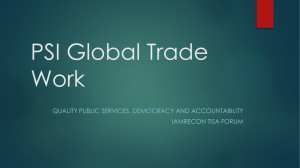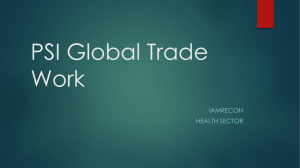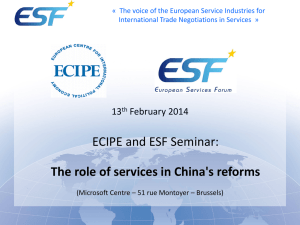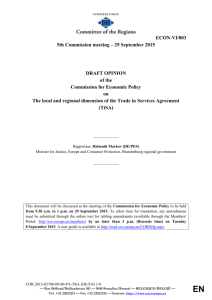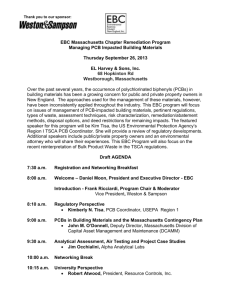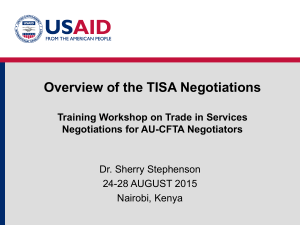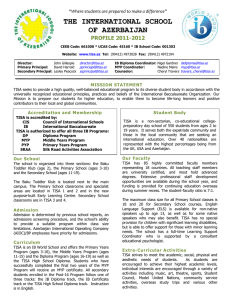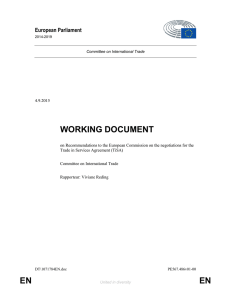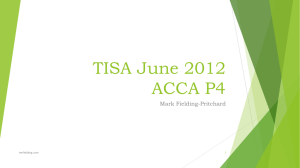Overview of the TISA Negotiations Training Workshop on Trade in Services
advertisement
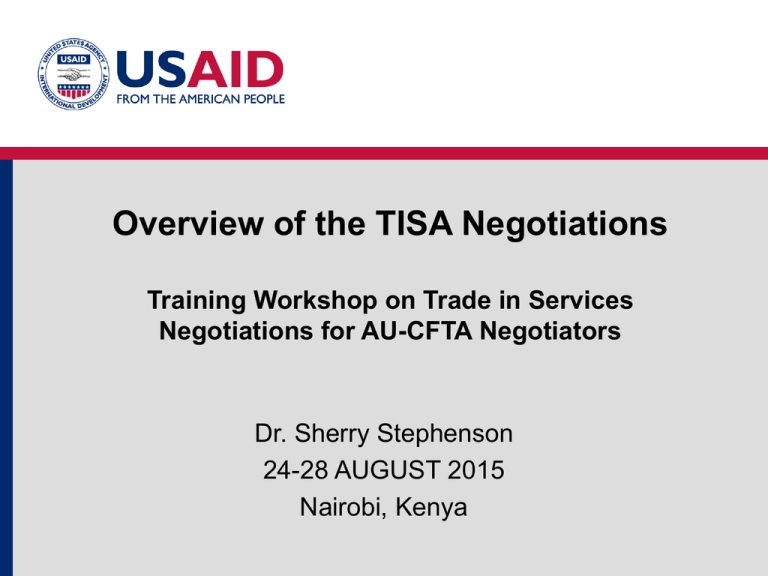
Overview of the TISA Negotiations Training Workshop on Trade in Services Negotiations for AU-CFTA Negotiators Dr. Sherry Stephenson 24-28 AUGUST 2015 Nairobi, Kenya What is Trade in Services Agreement (TISA)? • Product of frustration with slow progress in Doha Round and insistence on making results in services area dependent on those in agriculture • Objective To improve on the GATS and negotiate a higherstandard agreement on services among like-minded WTO members • 8th Ministerial Conference of the WTO in December 2011: to overcome the DDA stalemate, WTO Ministers committed to go ahead with negotiations in certain areas with the aim of reaching “provisional or definitive agreements based on consensus earlier than the full conclusion of the single undertaking”. • With this WTO blessing, interested countries took forward a plurilateral initiative in area of services, similar to ITA and EGA plurilateral initiatives What is Trade in Services Agreement (TISA)? • TiSA Negotiations • Initiative originally led by the US and Australia • • • • – TISA negotiations are the result of the business interest manifested in the services area; – Strongly backed by members of the Global Services Coalition TISA negotiations were begun in early 2013 and have continued during 2014 and 2015 Plurilateral negotiating sessions take place in Geneva; updates are regularly provided to the GATS Council on Services By July 2015, there have been 13 TISA negotiating rounds Negotiating sessions are hosted on a rotating basis by the U.S., Australia and the European Commission TISA Negotiating Participants TiSA PARTICIPANTS: Australia, Canada, Chile, Chinese Taipei (Taiwan), Colombia, Costa Rica, European Union, Hong Kong, Iceland, Israel, Japan, Liechtenstein, Mauritius, Mexico, New Zealand, Norway, Pakistan, Panama, Paraguay, Peru, Republic of Korea, Switzerland, Turkey, the United States, and Uruguay 25 Participants, including the EU 28nations in total China’s pending application, submitted in September 2013, has not yet been formally approved, and no indication has been given on when or if this will occur. TiSA Participants in the Global Economy • Around 70% of global trade in services • Almost 70% of World GDP • 23% of World Population BRICS BRICs account for 13% of global services exports. With their participation, TISA would cover 85% of global services trade. Four Pillars of the TISA 1. Basic GATS provisions (e.g. scope, definitions, market access and national treatment, exceptions) 2. GATS plus provisions (horizontal national treatment, standstill and ratchet plus market access "standards") 3. Regulatory disciplines (additional or strengthened) (domestic regulation, ICT services, logistics, financial services, maritime transport, government procurement and several others…) 4. Institutional provisions (accession, multilateralization, dispute settlement) Source: European Commision. Presentation “Plurilateral Trade in Services Agreement” (April 2013). Available at http://trade.ec.europa.eu/doclib/docs/2013/april/tradoc_151063.pdf Where do TISA Negotiations stand as of now? The 6-10 July 2015 meeting on the Trade in Services Agreement included: • A regular negotiating round, with discussion of market access offers; and • A “stocktaking” exercise, which involved a review of all negotiating topics, from offers to proposals to draft text. What is Next? • The TiSA negotiators are set to meet two more times this year, in October and December, and then aim to hold another stocktaking exercise in early 2016. • Possible aim for completion at end 2016. How is TISA being negotiated? • Hybrid Approach has been chosen for the scheduling modality – Market Access Positive List – National Treatment Negative List (but the latter will apply to all service sectors) EU has proposed a ‘modular approach’ to the TiSA structure Sectors being negotiated • • • • • • • • • • International Maritime Transport Services Air Transport Services Financial Services Electronic Commerce Telecommunication Services Environmental Services Movement of Natural Persons Professional Services Competitive Delivery Services / Logistics Government Procurement Texts: https://wikileaks.org/tisa/ Disciplines being negotiated – – – – – – – • Domestic Regulation Government Procurement Competition Policy / Monopoly Suppliers Mutual Recognition Transparency Small and Medium-sized Enterprises Others Expanded Temporary Movement (Mode 4) – Emphasis on expanded coverage of categories of skilled persons – Tailoring Mode 4 to skill qualifications of potential migrants – Discussion of ‘bonding’ requirements for semi-skilled Progress in TISA Negotiations so far • • • • • • • Financial services and domestic regulation: advancing well, with sources noting that there has been significant convergence in what should be in those annexes, though details still need fine-tuning. Telecommunications services, Mode 4, and E-commerce: reasonably far along. Maritime transport, transparency, and environment services: areas that have advanced, but to a lesser degree Government procurement, an EU proposal, is in the early stages of discussion, being a comparatively new proposal. Competitive delivery services, a proposal by the US, is considerable less advanced. Healthcare services, a proposal submitted by Turkey last year, is unlikely to move ahead All participants given until 31 July to submit new proposals on new topics. One new proposal is expected from the US on SOEs. Progress with respect to offers in TISA Negotiations • TISA parties are reportedly aiming to have completed offers from all participants in the last quarter of 2015. • To date, Pakistan and Paraguay have not yet tabled initial offers. • Existing offers from other participants are not yet fully complete and others are in the process of revision. • Uruguay and Mauritius, the newer participants in the group, may take longer to submit their own initial offers, some sources suggested. What are the potential benefits? • Quantifying potential expansion of services trade after completion of TiSA • Estimation of the service trade that would be generated by a 50% reduction in the tariff equivalent barriers (partial equilibrium; no dynamic effect) – Peterson Institute of International Economics, 2013 Overall annual service exports could increase by $78 billion for members participating in the TISA plus the BRICS What might be the implications for non-participants? • Since services agreements are by nature less “preferential” than goods agreements (difficult to apply a different set of regulations), non-participants will have the benefit of all regulatory disciplines negotiated by the TISA Members BUT… • GOVERANCE CHALLENGE: They will not participate in the rules design • MARKET ACCESS FOR SERVICES SUPPLIERS: Unclear as to the extension of market access benefits at present – will depend upon whether TiSA is applied as an Art. V preferential agreement or not TISA in WTO Context • For the WTO, TiSA is a Plurilateral Negotiation by WTO Members that voluntarily want to go beyond the GATS provisions by deepening their market access commitments and by designing new rules for services. • TISA will need to complying with GATS Article V, dealing with Economic Integration, to be WTO compatible – TISA will be a services-only agreement with “substantially sectoral coverage” in terms of: • Sectors, • Volume of trade, and • Modes of supply – Moreover, it will need to eliminate “substantially all discrimination” in services trade or refrain from imposing new discrimination by members Is there Potential for Multilateralization of TiSA? • Unclear at present • This is the aim of the EU and many other TiSA participants • Will depend on the willingness of TISA parties to offer the TiSA outcome on an MFN basis if it remains an Article V Agreement …… and on the possibilities of linking it or eventually incorporating it into the WTO – --As an entry into the Additional Commitments column of the TiSA participants? – As an Annex to the GATS? Is there Potential for Multilateralization? • Critical mass is relevant consideration for “multilateralization” (though no agreed number as a minimum requirement for this) – With China on board around 75% of world trade in services – With BRICS on board 85% of world trade in services • Then why not accept China? – Skepticism from the US, though China’s letter confirms a “high level of ambition” for the negotiations and promises that they will participate “positively, constructively and equally” – If China is in, other ASEAN countries that are already part of TPP (Singapore, Malaysia and Vietnam) will follow, probably resulting in more countries in the region also joining – This might lessen opposition from other BRICS countries Thank You Dr. Sherry Stephenson Sherry.Stephenson@gmail.com
